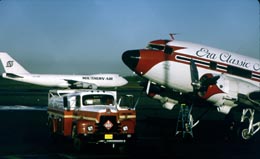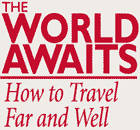Transport strategies, climate, and interest
Don't damage your own cause by choosing a route and itinerary that get you to destinations at times of least interest, beauty, or comfort.
The book takes a rich look at the details to consider to choose a route that suits you and your wallet. The larger points are expressed in the text and excerpts below.
"Dream-pruning is a good exercise. It’s a common mistake to plan for more activities and destinations than make sense given the real constraints of time, money, and distance. Smart pruning allows for plans to be reshaped wisely through attention to the realities of transport systems, regional infrastructures, climatic patterns, cultural variety, and your evolving interests."
Paul Otteson / The World Awaits / All Rights Reserved
Transportation Reality
"Only so many hours are available to experience the surface of the planet. On a 100-day trip, about 30 days worth will be spent sleeping; another 10 will be needed to eat, wash, find toilets, wait in line, etc. How much of the remainder do you want to spend in transit and how much on site?"
Paul Otteson / The World Awaits / All Rights Reserved
 Do the math! Do you really want to rail-pass your way to a dozen Euro-nations on a 6-week trip, or hit 20 countries on a pricey Round-the-World ticket with only 4 months available? No!
Do the math! Do you really want to rail-pass your way to a dozen Euro-nations on a 6-week trip, or hit 20 countries on a pricey Round-the-World ticket with only 4 months available? No!
Give yourself a chance to just be there -- and follow the Threaders Rules so that your transit time is more a part of your travel experience.
Airports: The Constraints Of Transport Routing
Here's one a lot of traveler's never consider:
"The location of major airports will have a lot to do with the routing of each overland segment of your journey. Long distance flights will take you to the starting point and away from the finishing point of those surface segments. In essence, your threads will connect airports."
Paul Otteson / The World Awaits / All Rights Reserved
If you want to make your ground time as worthwhile as possible, don't begin by considering the $50 or $100 air ticket price advantage available by choosing certain airports. That savings might disappear as soon as you get off the plane and find that you have to spend a day and $70 getting to your first destination of choice. Design your journey first, then reluctantly bend the ends of the thread so they intersect with airports.
Cost: How Much Is Too Much?
"It’s easy to see how the itinerary of travelers on a budget can be shaped by ticket costs. A round-the-world trip that includes surface travel in the eastern Mediterranean, the Himalayas, and the Golden Triangle costs far less than one that hits the Bolivian highlands, Okavango Delta, and the Milford Track. If your efforts to design a route are frustrated by transport reality, you may find your trip getting more and more similar to those taken by thousands of others before you—but don’t despair! They loved their travels and so will you!"
Paul Otteson / The World Awaits / All Rights Reserved
 In The World Awaits, you'll find details on the costs of various 'grand routes' around the globe. In general, the best deals are found along popular Eurasian routes served by several major air carriers, and the cheapest ticket packages are put together by the discounters -- check big city Sunday newspaper travel sections for their ads.
In The World Awaits, you'll find details on the costs of various 'grand routes' around the globe. In general, the best deals are found along popular Eurasian routes served by several major air carriers, and the cheapest ticket packages are put together by the discounters -- check big city Sunday newspaper travel sections for their ads.
Save the most money by staying out of the air! Yes, I know, it's hard to get from Athens to Perth via the surface of the Earth. But if you take fewer big leaps and spend the savings buying days and weeks on the ground, you'll get more travel for your money.
Following the Weather
"Every spot on the globe has a time or times during which the weather is most pleasant. The opposite is also true. If you would enjoy the benefits of moderate temperatures and clear skies, investigate the patterns. If you want to be roasted, drenched, frozen, sandstormed, blacked out, or eaten alive, investigate those same patterns with a different perspective."
Paul Otteson / The World Awaits / All Rights Reserved
On long journeys, planning the weather can be complex and often impossible. I recommend starting with whatever seems the most critical to you, and working from there. If you need to avoid the sweltering August heat of the Mediterranean and hit the perfect autumn trekking time in the Himalayas, start with these items and devise an itinerary that fits around them. Check out the book for details on the things you should consider, and how to piece together a climate-saavy itinerary.
Get Stranger As You Go
There are different theories on how to design a trip that brings you into contact with a variety of cultures and conditions. Some don't care one way or another. Others like to hit the wildest spots early, or towards the middle of a trip -- perhaps for the potent effect of the sudden change. I agree with those who like to get progressively more exotic as they go along. That way, each successive destination is fresh with interest, and you can sort of 'grow into' the weirdness.
 With the latter view, developing nations are likely to be in the second half of your plan, with Europe and the developed nations coming earlier. Starting from the U.S., many such trips will be eastbound, starting in northwestern Europe, going on to the Med and Eastern Europe, North Africa and the Middle East, then Sub-Saharan Africa or South Asia.
With the latter view, developing nations are likely to be in the second half of your plan, with Europe and the developed nations coming earlier. Starting from the U.S., many such trips will be eastbound, starting in northwestern Europe, going on to the Med and Eastern Europe, North Africa and the Middle East, then Sub-Saharan Africa or South Asia.
Obviously, this principle of planning will often break down at some point. Just remember that:...
"Berlin is fascinating after Boston—after Borneo, it might be boring."
Paul Otteson / The World Awaits / All Rights Reserved
Overwhelm Yourself
"I’m against overplanning a trip. Unfortunately, planning is so much fun that it’s difficult to avoid overplanning. The only answer is to over-overplan. By planning as if you were five people traveling for five years, you fill your mind with possible trip segments and approach again the potential for spontaneity that lets you feel free."
Paul Otteson / The World Awaits / All Rights Reserved
The goal, remember, is to be educated, entertained, and filled with wonder. Gain the kind of knowledge ahead of time that frees you to explore and discover -- not just the sort that keeps you marching down the beaten track with a sightseeing checklist in hand.
Return to Chapter 8
Continue to Chapter 10
Return to Road Reality

 Do the math! Do you really want to rail-pass your way to a dozen Euro-nations on a 6-week trip, or hit 20 countries on a pricey Round-the-World ticket with only 4 months available? No!
Do the math! Do you really want to rail-pass your way to a dozen Euro-nations on a 6-week trip, or hit 20 countries on a pricey Round-the-World ticket with only 4 months available? No! In The World Awaits, you'll find details on the costs of various 'grand routes' around the globe. In general, the best deals are found along popular Eurasian routes served by several major air carriers, and the cheapest ticket packages are put together by the discounters -- check big city Sunday newspaper travel sections for their ads.
In The World Awaits, you'll find details on the costs of various 'grand routes' around the globe. In general, the best deals are found along popular Eurasian routes served by several major air carriers, and the cheapest ticket packages are put together by the discounters -- check big city Sunday newspaper travel sections for their ads. With the latter view, developing nations are likely to be in the second half of your plan, with Europe and the developed nations coming earlier. Starting from the U.S., many such trips will be eastbound, starting in northwestern Europe, going on to the Med and Eastern Europe, North Africa and the Middle East, then Sub-Saharan Africa or South Asia.
With the latter view, developing nations are likely to be in the second half of your plan, with Europe and the developed nations coming earlier. Starting from the U.S., many such trips will be eastbound, starting in northwestern Europe, going on to the Med and Eastern Europe, North Africa and the Middle East, then Sub-Saharan Africa or South Asia.